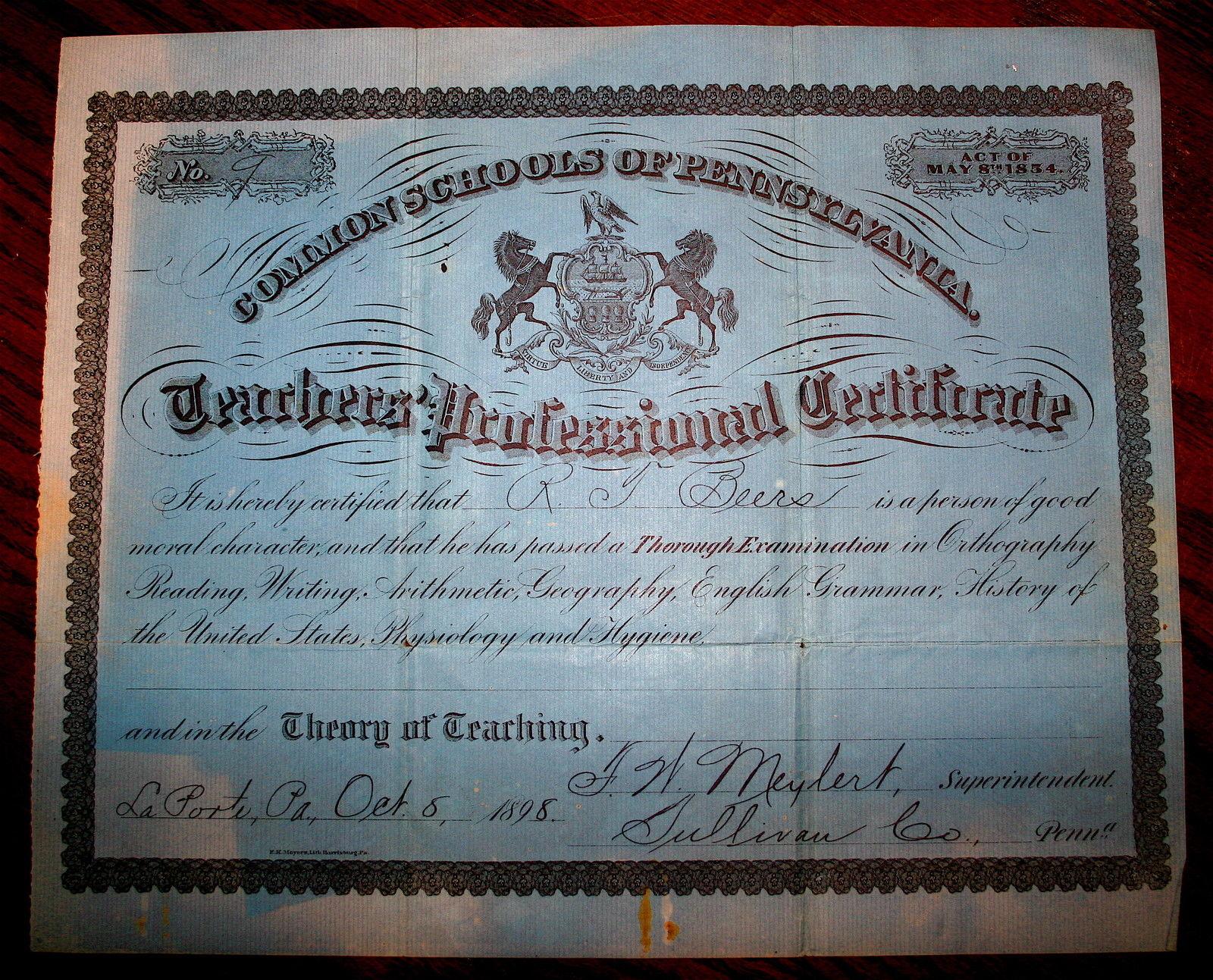Settlers XXX: The PEALER-WENNER-LAWRENCE-LADD-DIEFFENBACHER FAMILIES
by
Thomas Pealer
Printed for Distribution to Family and Friends
1947
All photos shown here scanned from the original text except where indicated
Source: Several Hess and Pealer family members
Also available at Sullivan County Historical Society, Laporte, PA
Dedicated to the Memory of
The Three Engineers:
JOHN DIEFFENBACHER (1813-1903)
Designer and Builder, Covered Bridges
DAVID PEELOR (1811-1895)
One time Chief Engineer, Cambria Iron Company
Engineer and Scientist
PROFESSOR SAMUEL J. PEALER (1833-1920)
Teacher, Engineer, Civil War Veteran
Introduction
This little booklet, giving records and short biographical sketches of the Pealer- Wenner- Lawrence-Ladd-Dieffenbacher Families, is the fruit of extensive toilsome research.
Sources for these family records are old bibles, county histories and cemetery markers, and are therefore, authentic. Historical data and biographical sketches, on the other hand, were drawn from memory, having been passed down the line in true family tradition.
Members of the clan who were bothered by letters with requests for photographs and data pertaining to the family records can now see the purpose of furnishing this information. It is hoped that they will continue to supply the details for their immediate families, thus keeping the record up to date. Thanks.
Acknowledgments
For valuable help rendered in the preparation of this work, the author is especially indebted to the following person:
Cora Pealer Potter, Williamsport, Penna.
Eva Lawrence, Narbeth, Penna
Marion Pealer, Stillwater, Columbia County, Penna.
Angie Heverly, Sayre, Penna.
Marjorie Killgore Hantz, 485 S. Franklin St. Wilkes-Barre, Penna.
A.D. Lawrence, Canton, Bradford Co., Penna.
Mary Jane Pealer Northover, 31 Hodge St., Buffalo, N.Y.
Ruth Pealer Hess, Coraopolis Hghts., Coraopolis, Penna.
Elma C. Bishop, Berwick, Penna.
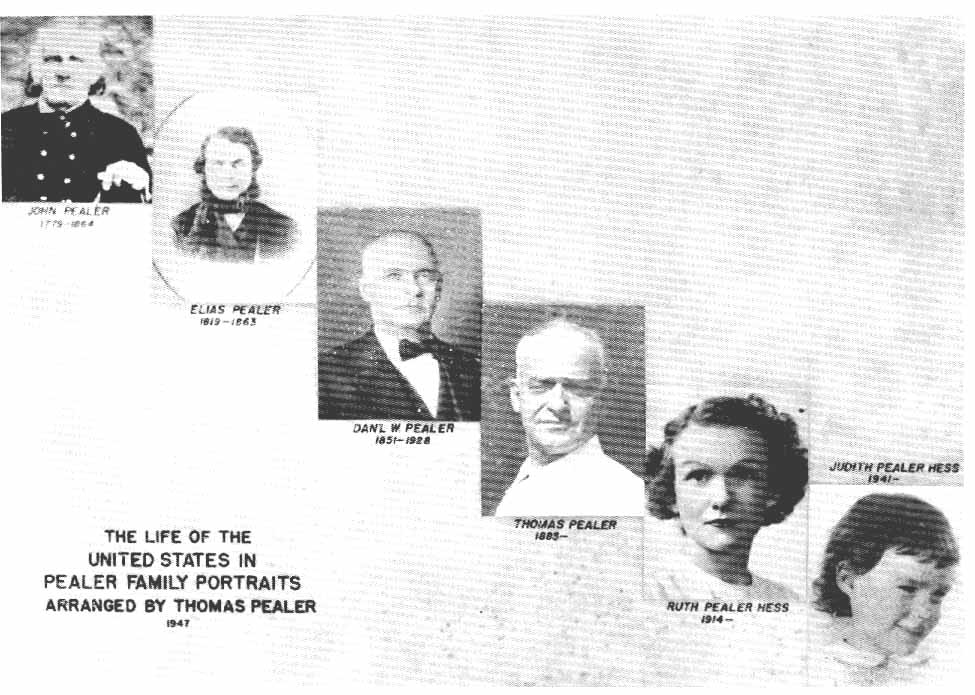
The Life of the United States in Pealer Family Portraits
Arranged by Thomas Pealer 1947
John, Elias, Daniel, Thomas, Ruth, and Deborah
Photo scanned by Derek Davis
The Pealer- Wenner - Lawrence - Ladd - Dieffenbacher Families and their descendants represent the average of the great middle class people of America. They were born. They lived. They worked and died.
The Pealer Family
The German name was originally Pealer - Buller- Buchler- Bueler. There are many English spellings: Pealer, Peelor, Beeler, Beiler, Beler and Bealer. The Military record of PAUL on file in the Archives, Harrisburg, Pennsylvania, gives the spelling as Beeler or Bealer; The ELIAS Bealer bible, as Bealer. It remained as such until about the time of the Civil War, when it was generally changed for the Columbia County connection to Pealer.
The ancestry of the family in America begins with the moth-eaten story of the three brothers landing in Philadelphia from the old country. Father Pealer told many times of the three brothers coming to America from Germany about the year 1725 and settling in Berks County, Pennsylvania. He said that we were descendants of Jacob, the oldest of the three brothers. This made a good bedtime story and was often told to the children with some elaboration here and there to make in interesting. The story is not a story at all, but a fact, which has been verified in the book, The Pealor Family, compiled by John W. Peelor of Rockwell, North Carolina, in 1935.
Chapter No. 1 of The Pealor Family, reads as follows:
"Johannes Buller and his family sailed from London on the ship Molly (John Hodgeson, Captain), arriving at Philadelphia, September 30, 1727. Jacob, David and Michael were the children of the family. Jacob and David settled in Pennsylvania. David later settled six miles west of the town of Indiana, where some of his descendants live at the present time. Jacobís location is not known, nor is there any information about his family. There is no record of Johannes Bullerís wife, or the ages of the children when they arrived in Philadelphia. Tradition, however, gives Michael as the youngest son."
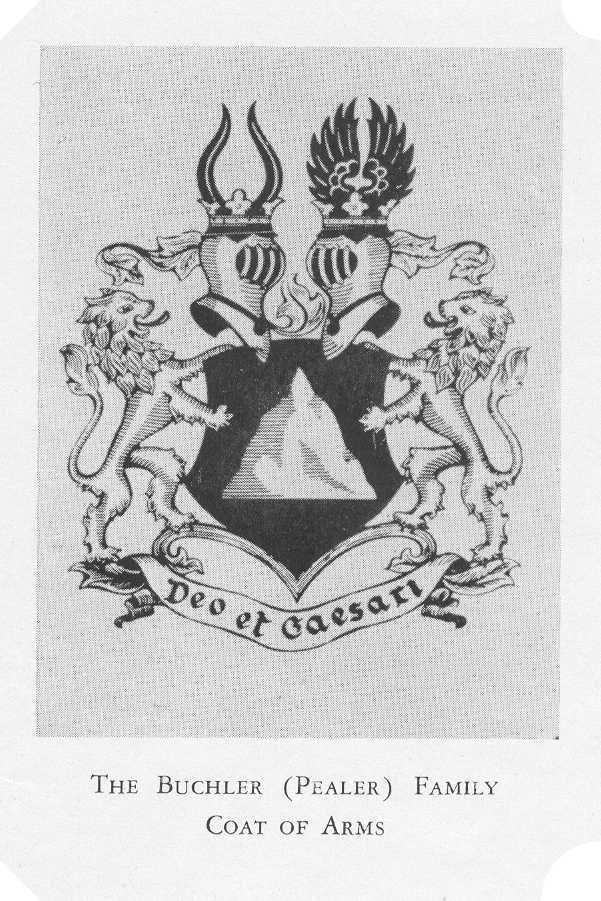
Volume No. 1 of Pennsylvania German Pioneers, by Strassberger and Hinke, indicates on pages 13 and 14 ship list and endorsed list of the sailing vessel MOLLY, landing at Philadelphia, September 30, 1727. List 3-A (ship list) has the name JOHANNES BULLER, also fourth from the last. It is apparent, therefore, that the Pealer name and the Buller name represent the same person.
The oldest of the three brothers who landed in Philadelphia with their father, Johannes, on September 30th, 1727,
was Jacob, who remained in Berks County, Pennsylvania and was the father of PAUL, the Revolutionary War veteran.
The author of The Pealor Family was a direct descendant of Michael, the youngest of the three brothers. In his book of 248 pages, Mr. Peelor shows in great detail, the story of this branch of the family, most of the members of which lived in the south and west. He gives some data regarding David, who settled in what is now Indiana County in 1782 and was later killed by Indians. It is also interesting to note the following biographical sketch he writes about David Peelor, the great-grandson of the original David.
"David Peelor was one of the noted Civil Engineers of Pennsylvania, and it was he who first discovered the principles of telegraphy. By him, it was communicated to S. F. B. Morse, who had it patented. This was worked out on the David Peelor Plantation, six miles west of Indiana, Indiana County, Pennsylvania."
David Peelor was at one time County Surveyor of Indiana County. In 1854, he made the first map of the county, showing all roads, streams, towns and villages. It also indicates names of farms along the roads he traversed in making surveys. The original county map and many of his drawings of farm and property maps are on file in the Pealer engineering office in Indiana.
The coat of arms here shown was taken from The Pealor Family. Following is the notation of grant:
"In 1622, arms were granted to Nicholas Buchler and his cousin Daniel. They were relatives in the High Counsel of Nuerenberg, Germany.
Mr. L.M. Peelor, Attorney, Indiana, great-great-great-great-grandson of the original David Buller or Pealer, helped in compiling some of this date and has in his possession, The Pealor Family, by John W. Peelor.
PAUL BEALER (great-great-grandfather)
Son of Jacob Pealer or Buller
Paul Bealer Born about 1740, Berks Co, Pa; Died September 1st, 1796
Married Charlotte Speiglemoyer. She was born in 1741; Died February 21, 1806
The Samuel Bealer bible was printed by D. Fenshaw in 1833 (Rev. G. Townsend of Cambridge, England), and published by N. and J. White, 108 Pearl Street, New York City. It mentions six children of the Bealer-Speiglemoyer union as follows.
Daniel born 1765
Catherine born 1771
JOHN (great-grandfather) born March 22, 1779; died May 29, 1864
Mary (twin of John) born March 22, 1779
Jacob
Samuel born September 28, 1782; died 1854
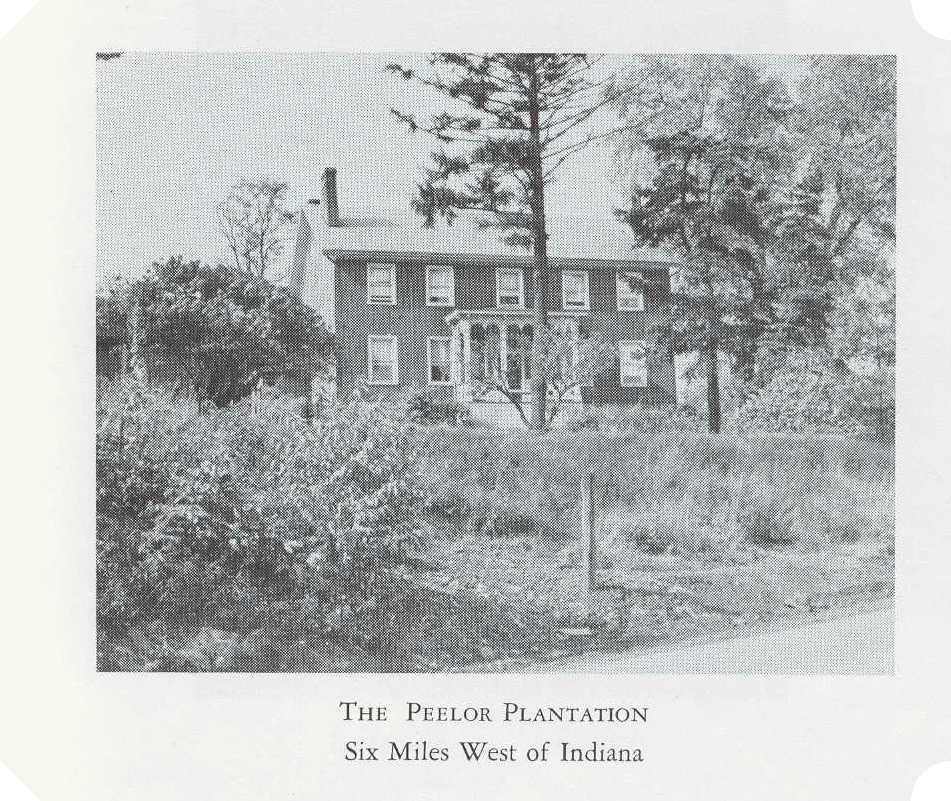
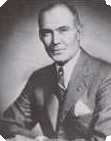
L.M. Peelor
Attorney, Indiana, PA
Daniel married Barbara Stucker on December 10, 1792
Catherine married first, Daniel Stucker; second, John Bright.
JOHN (great-grandfather) married Mary Magdalena on August 30, 1807
Mary married Jacob Yaple
Samuel married Magdalena Shida on November 13, 1804
MILITARY RECORD OF PAUL BEALER
Reference: Pennsylvania Archives, Harrisburg (Series #5, Volume #3, Page #255). He received depreciation pay from the Berks County militia and served as a private in the Revolutionary War.
Paul was quite a rover as he traveled back and forth between Reading and the Fishing Creek Settlement, Northumberland County. After the war, he returned to Reading and must have remained there for some time, since his name is on the personal tax list for the years 1780-1781-1784-1785. Whether his wife and family accompanied him on the frequent trips is not known. However, the family became residents of the Fishing Creek Valley. His wife, Charlotte Speiglemoyer Bealer, is buried in the Zion Cemetery near Stillwater, now Columbia County. Paul died in Reading on September 1st, 1796. Evidently, he was a resident of the Fishing Creek Country at the time of his death because his will is recorded in the Court House, Sunbury (Volume #I, Page #179).
Except for the date of birth, we have no records of Daniel, Catherine, Mary and Jacob. Facts of JOHN (great-grandfather) are in the record. Samuel (1782-1854) was born in Berks County. He was a miller and farmer and did a great deal of traveling about the country. He died in the state of Iowa. He was the father of Samuel J. (1833-1920), who was an eminent educator and engineer, known throughout Columbia County as Professor Pealer.
JOHN BEALER (great-grandfather), son of Paul
Born March 22, 1779; died May 9, 1864. Married August 30, 1807 to Mary Magdalena. She was born February 24, 1791; died October 30, 1845.
Children:
Salome: Born November 18, 1808
Thomas: Born April 29, 1811; died at Dushore 1902.
John: Born November 5, 1813
ELIAS (grandfather): Born February 1819; died September 12, 1863.
Susannah: Born June 9, 1816; died February 1, 1831
Abraham: Born January 28, 1822
Daniel: Born April 8, 1825; died November 10, 1846
Mary Magdalena: Born August 6, 1828
Samuel D.: Born January 19, 1831; died in Kansas.
ELIAS (grandfather) married Susannah Wenner October 12, 1840.
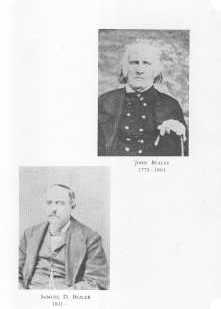
Top: John Bealer (1779-1864)
Bottom: Samuel D. Bealer (1831-)
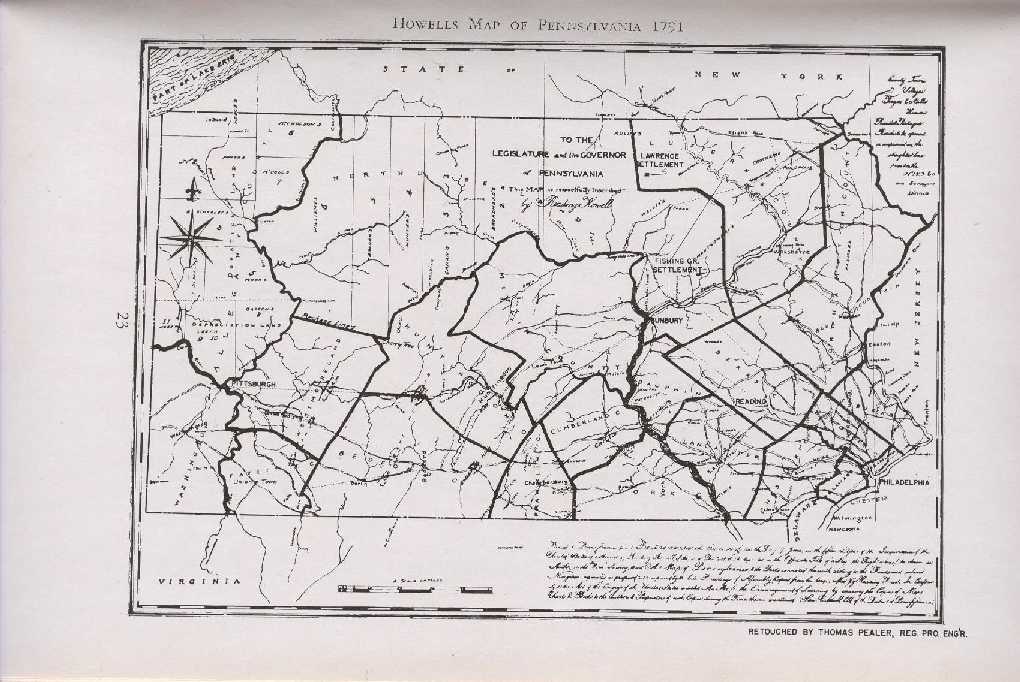
Howells Map of Pennsylvania
1791
Retouched by Thomas Pealer
Magdalena married Reuben Bostain August 4, 1846
Samuel D. married June 27, 1857.
The original bible of JOHN BEALER is now owned by Mrs. Allen Brown, Shickshinny, Pennsylvania, formerly owned by her father. This bible was stereotyped, printed and published in 1841 by H. and E. Phinney, Cooperstown, New York.
JOHN BEALER was a farmer and at one time owned a large tract of land between Benton and Fishing Creek Township. He later moved to a farm near Stillwater, adjoining what was later known as the ELIAS BEALER farm.
Son Thomas (1811-1902) was a shoemaker by trade. During the later years of his life he had a shop in
Dushore, Sullivan County. He was the father of Charles, proprietor and owner of
the well-known Pealerís Corner Drug Store, Dushore.
Editor's Note: You can learn more about Charles E. Pealer in the Ingham History of Sullivan County.
Son John (1813- ) located in Shickshinny. He was the grandfather of Mrs. Allen Brown, who has possession of the original JOHN BEALER family bible.
Son ELIAS (grandfather): Facts about his son are in the record.
Son Samuel D. (1831- ) migrated to the west when a young man. He settled in Kansas where he spent the balance of his life as a prosperous farmer and businessman.
[Reference to Will of JOHN BEALER, Bloomsburg Court House (Will book #3, page 474), gives names as follows: Samuel, Salmome, Magdalena, Abraham, Thomas, ELIAS, and John. Will made on November 17, 1857. Witnesses: James Chamberlain and C.M. Baker. Executor: Robert F. Black, Bloomsburg.]
ELIAS BEALER (grandfather), son of John
Elias Bealer born March 19, 1819; died September 12, 1863.
Married October 12, 1840 to Susannah Wenner. She was born February 14, 1822; died May 21, 1875.
The original ELIAS BEALER bible is in possession of Thomas Pealer, Indiana, Pennsylvania. Records of eleven children are found therein:
Sarah: Born September 3, 1841; Died December 27, 1911
Jacob: born October 10, 1842; Died January 15, 1876
Melinda: Born October 21, 1843; Died September 13, 1865.
Francis M. born May 27, 1845; Died November 24, 1924
Mary Elizabeth Born April 30, 1847; Died March 22, 1937.
Rachael: Born May 30, 1849; Died June 26, 1878.
DANIEL WENNER (father) Born February 21, 1851; Died December 3, 1928
Susannah: Born April 23, 1853; Died November 10, 1873.
Wm. Goodrich: Born November 3, 1855; Died December 12, 1928.
Alfred Nevin: Born January 3, 1858; Died March 13, 1919.
Elias Oliver: Born June 26, 1860; Died November 16, 1943.
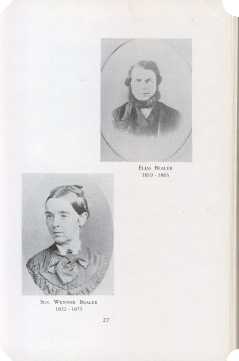
Top: Elias Bealer (1819-1863)
Bottom: Susannah
Wenner Bealer (1822-1875)
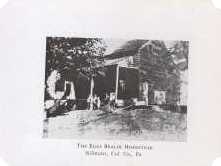
The Elias Bealer Homestead
Stillwater, Columbia County, PA
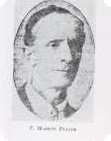
Francis Marion Pealer (1845-1924)

Frant Pratt and Mary Elixabeth Pealer Pratt (1847-1937)
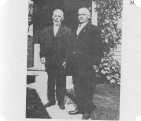
Francis M. Pealer (1845-1924) and
Daniel W. Pealer (1851-1928)

Rachael Pealer Wolfe (1849-1878)
Photo scanned by Derek Davis
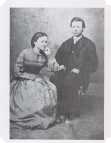
Lodeska Wilcox Pealer and
Jacob Pealer, Civil War Veteran (1842-1876)
Sarah- never married
Jacob-married Lodeska Wilcox on April 15, 1866
Melinda-married John Minnick
Francis M. married B. Cramps January 1, 1874
Mary Elizabeth- married Frank Pratt July 12, 1869
Rachael- married Philip Wolfe
DANIEL WENNER-married Elizabeth Ann Lawrence Feb. 16, 1875.
Susannah- never married
William Goodrich- married Cecelia Yaple
Alfred Nevin- married Betha Bengtsses.
Elias Oliver- married Cora Taylor, November 1, 1883
ELIAS BEALER was a farmer and shoemaker by occupation, therefore a man of versatility. By conviction he was a member of the Reformed Church and a Democrat. He was active in the affairs of the Township. And from a later chapter on the Fishing Creek Confederacy, he must have been extremely active as his farm at Stillwater was in the very center of the troubled area.
SUSANNAH WENNER BEALER (Facts of this daughter are in the record of the Wenner family)
SARAH, the oldest of the family, never married. She is deserving of great credit for assisting her mother in running the farm and in keeping the family together after the death of her father. She lived for some time with her uncle, Samuel Pealer, in Kansas. Sarah was a woman of marked individuality, dominating all with whom she came in contact.
JACOB M. learned the shoemaker trade with his father on the Pealer farm. He served in the Union Army throughout the Civil War. After the war, he conducted a shoe shop at Dushore, Sullivan County. He died at the early age of thirty-four as a result of army service. Two daughters survived: Bertha Pealer Deegan and Winifred Pealer Wagner, both of Dushore
FRANCES M. became the owner of the Elias Bealer farm at Stillwater, Columbia County. He was a highly-successful farmer and a leader in church and civic affairs. He was the father of Marion D, who until recently was the owner and operator of the Pealer farm at Stillwater. Marion was at one time County Commissioner of Columbia County.. And it was her who furnished valuable data for the Pealer history. Frances M. died at the home of his daughter, Josie Lanker, Harrisburg, Pennsylvania, November 24, 1924.
MARY ELIZBETH married Frank Pratt who was a lumberman and timber estimator. They lived their entire married life in Williamsport, where they celebrated their sixty-fourth wedding anniversary July 12, 1933.
DANIEL WENNER PEALER (father) Facts of this son in family record.
RACHAEL married Philip Wolfe and lived in Williamsport, where she died June 26, 1878.
WILLIAM GOODRICH, named for Rev. Goodrich of the Reformed Church, Fishing Creek Township, was a trader and drover. He bought cows and farm products around his old home in Columbia County, selling them in Wilkes-Barre and Wyoming Valley. Uncle Will once said, "The best way to sell a cow to a coal miner was to stick a union label on her rump." William had two children: Harriet, married to Professor Reese Killgore, noted educator, and Ralph who always lived with his father.
ALFRED NEVIN was by trade a blacksmith. He worked in the lumber woods of Cameron County, where he was accidentally blinded while engaged at his trade. Some years later he entered the industrial home for the blind in Philadelphia, where he lost his life March 13, 1919, by falling down an open elevator shaft. Bertha Bengtsses Pealer and the children of Nevin live in and about Elmira, New York.
ELIAS OLIVER, The youngest child of ELIAS learned the trade of telegraph operator, while living with his brother Daniel at Dushore. He married Cora Taylor of Towanda where he was employed by the Railroad Company. Later, he became chief train dispatcher for the Lehigh Valley Company of Sayre, Bradford County. Oliver was an expert fisherman, devoting all of his spare time to this sport. He was the sole inventor of the ball bearing propeller spinner fish hook, known by the trade name of the "E.O.P. SPINNER." This hook was used successfully for trout, crappie, pike and muskelunge. He manufactured them in large quantities at the Pealer Fish Hook Factory at Sayre. Defending himself against infringement by large interests upon his patent rights cost him his business. Afterward, he was employed as foreman by one of the very companies that infringed upon his patent rights. He died at the home of his daughter, Martha Pealer Bussey, Herkimer Road, Utica, New York.
THE FISHING CREEK CONFEDERACY
Any record of the Pealers or the Wenners that fails to take account of the Fishing Creek Valley and its history is inadequate, for it was there at its very center, the village of Stillwater, where the Pealers and Wenners lived. There the authorís father romped as a boy and witnessed those scenes which have given the region a place in history.
The valley is for the most part hghly productive, save in the north where it becomes rugged and hilly and was formerly covered with a prolific growth of giant hemlocks. In area it is from one to three miles in width and some thiry miles in length. It commences at Bloomsburg, where the waters of the Fishing Creek flow into the Susquehanna and extends to the North Mountain in the neighboring county of Sullivan.
The first school in Fishing Creek Township was taught by Christopher Bealer in a weave shop, located on the spot where John Zanerís residence once stood. The first school house was built at Pealertown, in which Jonathan Colley taught.
The first post office in the township was opened in the year 1849 with Daniel Bealer, grandson of the Revolutionary War veteran, Paul, as the postmaster.
The Fishing Creek Valley was first settled by Germans, who after brief sojourns in Berks County came there. This immigration began at about the commencement of the American Revolution, continued to the dawn of the nineteenth century and then ceased. A few Scotch-Irish were here, but they were so thoroughly absorbed by the native Germans, that years afterwards they could not be distinguished from them. They held to the German customs and retained their native tongue, which afterwards developed into Pennsylvania Dutch. English was hardly spoken at all. There was little contact with the outside world. They became a static people, acted in unison and voted solidly Democratic, with marked pro-southern leaning. Thus, when the war between the states finally broke out, their sympathies were largely with the Confederacy. Many of their sons enlisted or were drafted into the Federal Armies, but a few fled across the Mason and Dixon Line and enrolled under the Confederate banner. The quiet of the Fishing Creek Valley was rudely interrupted by the din of the strife. The conflict was discussed as they met on the roads, alluded to from the pulpits and at their meeting places. The longer it lasted, the more they viewed the effort of the North to suppress the secession movement as a useless expenditure of blood and treasure, and a hopeless undertaking of a majority to inflict upon a minority. They became convinced that the Union had become unworkable and therefore should be dissolved. Then in August of 1864 an event occurred which stirred these sentiments to a white heat.
On the first of August of that year, four furloughed soldiers of the Federal Army, while riding through the valley, encountered a man named Young whom they ordered to halt.
When he disobeyed their command, they fired, but missed. Young replied in kind and one of the four, Lieutenant Stewart by name, fell to the earth mortally wounded. The news spreading like wildfire, aroused the people of the valley to a high pitch of excitement. Soon Federal troops began to appear at Bloomsburg and from that point more than 1,000 of them spread out over the entire valley like a swarm of locusts consuming the substance of the people, a practice customary among armies of occupation. They began an intensive search for the bands of armed men who were supposed to be lurking everywhere, but found none. They combed the surrounding hills for cachets of arms and ammunition that were thought to exist, but with no better results. They penetrated the caves and wilderness of the North Mountain country in the adjoining Sullivan County in a useless quest for the cannon they were certain had been concealed there and the fort they knew had been constructed. Guards were even placed at the polls to make certain at the fall election that no traitors would be chosen for public office.
Largely with rumor as a basis for their accusations, courts martial were established throughout the whole valley, and practically all of the male citizens were hailed before them. Those upon whom a semblance of guilt was thought to be established were spirited away to Harrisburg and other points for further examination and imprisonment.
So great was their zeal that only with reluctance did they consent to release one David Lewis on trial at Fort Mifflin when they could obtain nothing that could be considered proof of guilt from the loyal Professor Samuel J. Pealer, an eminent teacher and engineer of that country. Those sent to prison remained there a few months and then were finally released. Here the matter should have ended. And it might have, but for the recent efforts on the part of many to vindicate the conduct of neighbors and ancestors and to vilify the acts of those whom they deemed their oppressors-unmindful that the pursuit of such a course merely serves to revive memories that might well be forgotten and to lay open wounds which time alone could heal.
Even the superficial student is aware that in the South, scenes like those enacted in the Fishing Creek Valley took place only on a larger scale. Notably was this true in Eastern Tennessee where the efforts of secession to suppress the loyalty of the inhabitants knew no bounds. In like manner, so pronounced was the loyalty of Andrew Johnson to the Federal authorities, that his life was in jeopardy for years.
DANIEL WENNER PEALER (father) son of Elias
Daniel Wenner Pealer born February 21, 1851; died December 3, 1928. Married Elizabeth Ann Lawrence February 16, 1875. She was born August 21, 1854; died May 27, 1928.
The Daniel Pealer family bible is in possession of Thomas Pealer. It gives the following records:
Anna Fluetta: Born January 25, 1876; died September 17, 1927
Merton Lindley: Born January 19, 1877
Nattie Woodward: Born February 20, 1879; died March 8, 1928
Hattie: Born February 20, 1879; died July 24, 1879
Cora Elizabeth: Born May 15, 1881
Thomas: Born August 1, 1883
Anna Fluetta- married F. C. Meyer, April 18th, 1901
Merton Lindley-married Jennie Wilcox
Nattie Woodward- married 1st Ida Ishenbach; 2nd, Floda Johnson
Cora Elizabeth- married 1st William Myers, October 17, 1922; 2nd Milton L. Potter, December 24, 1936.
Thomas- Married Mary Caldwell, May 25, 1909.
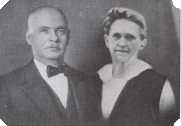
Daniel Wenner Pealer (1851-1928) and
Elizabeth Ann (Lawrence) Pealer (1854-1928)
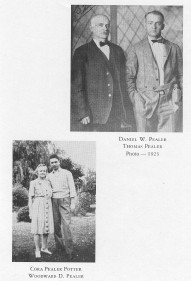
Top: Daniel W. Pealer and Thomas Pealer in 1923
Bottom: Cora Pealer Potter and Woodward D. Pealer in 1946
DANIEL WENNER PEALER (father), was confirmed in the Reformed church, Fishing Creek Township, Columbia County in the year 1859. He remained at home until he was 20 years old. From there, he went to Williamsport, where he learned the trade of upholstering. He followed this trade in New York City for some time, afterwards locating at Dushore, Sullivan County as an apprentice to his brother, Jacob. Daniel learned the trade of shoemaker and harness maker and then started in business for himself at Canton Corners, Bradford County. Returning to Dushore a couple of years later, he acquired the shop formerly occupied by his brother Jacob. Then he moved to Laporte, the county seat of Sullivan County and remained there until 1884, when again he returned to Dushore. In the year 1889, he located a shoe and harness shop at Lopez, a new lumber town at the junction of the Loyal Sock and the Lopez Creeks. The move to Lopez was prompted more by favorable trout fishing waters than by favorable business opportunities. He was an ardent fisherman, fashioning his own fish lines from horse hair on which he assembled tiny minnow hooks. This tackle was effective when cast to the hungry trout in the upper reaches of the Lopez Creek. He was an early morning fisherman, and often would have his catch ready for the family breakfast. Dan Pealer was well informed, and was a typical country shoemaker philosopher, who told tall stories of the many happenings back home (Columbia County) and about the small trout he caught on the back cast. He told of how he used the same trout for bait and caught the sixteen-inch whopper on the first forward cast in that deep hole on Pigeon Creek, just above the Sock. He was active in politics and, true to family tradition, was a Democrat. At the time of his death he was a member and deacon of the United Evangelical Church of Lopez.
ELIZABETH ANN LAWRENCE PEALER (mother), the daughter of John Horatio Lawrence, was born on a farm one mile east of Dusohre, Sullivan County. She was nineteen when her mother, Susannah Dieffenbacher Lawrence, died, leaving eleven children, the youngest of which was Frank, less than one year of age. A large part of the responsiblility of keeping the family together after the death of the mother was borne by the eldest child. However, she somehow found time to complete her education in the common schools and taught one winter. She married Daniel Wenner Pealer, February 16, 1875. They started their married life at Canton Corners, Bradford County, where their first child, Anna F., was born. It was move-move and more move for Elizabeth and her family, but finally they located at Lopez, Sullivan County in 1889 with a family of five small children. At that time Lopez was more of a lumber camp than a town. The houses were of plank frmae construction, cold as cold in the winter and extremely hot in the summer time.
The earnings from husband Danielís shoe and harness shop were meager. With little coming in and Danís liberality in helping others before he helped himself, often left a difficult problem for the manager of the household. Renting a room to a school teacher now and then and taking in an occasional boarder helped to make ends meet. In the early days of the lumber town, fresh vegetables, milk and eggs were real luxuries but seldom seen on the family table. Berries, watercress, dandelions, beechnuts, fish and wild game supplemented the dietary deficiencies we hear so much about today. In later years a house, with conveniences, was built that was thoroughly enjoyed. At the time of her death, May 27, 1928, she was a member of the United Evangelical Curch of Lopez. Elizabeth Ann and Daniel Wenner Pealer are buried in the Behrs Cemetery near Dushore.
ANNA FLUETTA was born at Canton Corners, Bradford County. Her education included common schools at Dushore and Lopez. She married Fred C. Meyer, Mining Engineer. They lived at Peckville, Luzerne County and at Windber, finally locating on a small farm near Lake Ariel, Lackawanna County, where Mr. Meyer followed the business of truck farming and land surveying. Anna died September 17, 1928. She is buried in a church cemetery near Lake Ariel.

Anna Pealer Meyer
1876-1928
MERTON LINDLEY, born at Dushore, Sullivan County, January 19, 1877. Mert has been barber, storekeeper and sign painter. He is a hobbyist and entertainer. His hobbies have been many and varied. At present he does trick and fancy roller skating, juggling and amateur ventriloquism, performing under the name of "Derio". He married Jennie Wilcox and lives at Canton, Bradford County. They have four children living: Gladys, married to Roderick Kelley, Canton, Pennsylvania; Frank, professional acrobat and circus performer, known by the circus name of "DERISKI." He is married and has five children, all of whom are at present with the King Brothers three-ring circus, featuring the"Deriski Family Act." Lindley is a taxidermist and lives at Canton. He was recently discharged from three years service in the merchant marines. Cora Helen is married to John Wentzel. They live at Sunbury, Pennsylvania.
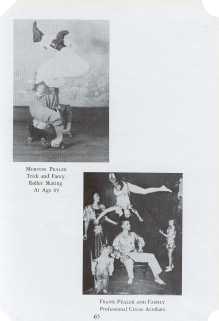
Top: Merton Pealer
Trick and Fancy Roller Skating
At Age 69
Bottom: Frank Pealer and Family
Professional Circus Acrobats
NATTIE WOODWARD was born at Dushore. He pursued the occupation of butcher and meat cutter. He made his residence at Lopez and several places in West Virginia. He died March 8, 1928 and is buried at Elkins. Nat had two sons from second wife Floda: Woodward D., recently discharged from three years service overseas, United States Army Air Forces. His present address is 766 Maryland Avenue, Cumberland, Maryland. Lawrence, the second son, found employement in the movie industry as an artist on paintings, etc. His last known address: Technicolor Movie Studio, Hollywood, California.
HATTIE, twin of Nattie, died in infancy.
CORA ELIZABETH was born at Dushore, Sullivan County. She graduated from Lopez High School, 1899; graduated from the Williamsport Hospital R.N.., 1919. She was a practicing nurse until her marriage to William Myers, October 17, 1922. Mr Myers died May 10, 1929. On December 24, 1936 she married Milton Potter, an old neigbor she grew up with, formerly from Lopez. Cora carries on a voluminous correspondence with the relatives on all sides of the family. She knows exactly where they are and who they are. Without her help, this little book would have been impossible. She lives at 367 Lincoln Avenue, Williamsport, Pennsylvania.
THOMAS (See record)
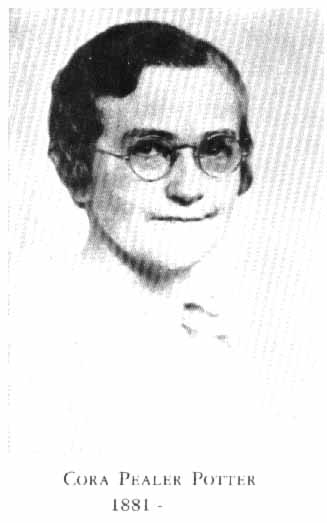 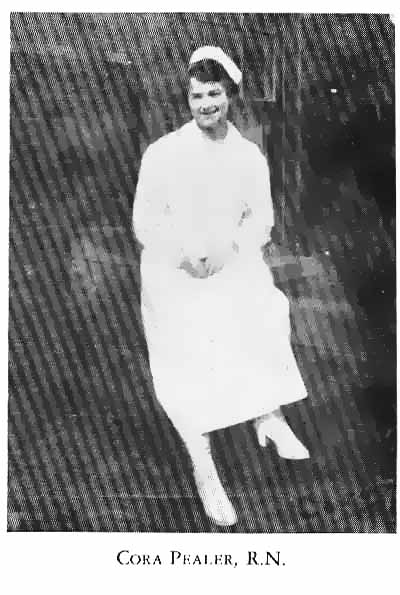
Cora Peeler Potter, RN
1881-
Photos scanned by Derek Davis
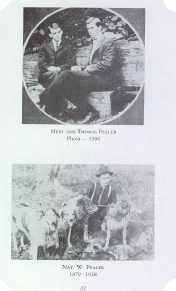
The Pealer Boys
Top: Mert and Thomas Pealer in 1906
Bottom:
Nat W. Pealer (1879-1928)
The Lopez of 1899
Lopez, Sullivan County, Pennsylvania, is located at the Junction of the Loyal Sock and the Lopez Creeks. The first settlement here was known as Tar Bridge, afterwards changed to Lopez in memory of an early Spanish settler by that name.
Editor's Note: This comment is not accurate. The town was actually named for John Lopez, an early settler and merchant in the area.
Surrounding this village was a virgin forest of huge proportions, located in three of the neighboring counties- some 250 square miles in extent, an area grater than that which many of the counties of the Commonwealth can boast. Chief among the trees of this vast woodland were giant hemlocks, many of which were fifteen feet in circumference, lifting their braches 125 feet into the air. Two other varieties of the evergreen type, spruce and tamarack, grew in the swamps and lowlands. Perhaps the remaining fourth of the timber in this great woods consisted of the hardwoods: beech, birch, maple and wild cherry.
So inadequate were the means of transportation in those early days, that often only the bark would be marketed, thus leaving millions upon millions of feet of the finest hemlock timber that ever grew to rot and decay. An idea of the amount of timber in this woodland becomes apparent when it is estimated there was enough of it to construct a boardwalk two inches thick and ten feet wide that would reach around the earth.
About this time and during the next few years that followed, the exploiters of lumber appeared upon the scene. They bought up or leased vast acreage of timber land. They erected sawmills capable of manufacturing enormous quantities of lumber. This led to the building of roads and the construction of railways for handling the product. Names that still dwell in the memory of the author are: Jennings Brothers on the Loyal Sock at Lopez; Henry Turrell on the Lopez at Turrelltown; Kipp and Kiser on the upper reaches of the Lopez at Kipptown or Newell; Trexler and Turrell on the headwaters of the Mehoopany at Ricketts; Albert Stull on Bowmans Creek; Jake Stroud on the Western slopes of Pigeon Creek; the Shermans at Sherman Run on the Lee Settlement Road; the Jamison City mills on the North Mountain; the Clark brothers, skidding and logging contractors at Cabin Run; and Old Dave Brown, the great bear hunter and skidding contractor from out the Thorndale way.
The conveying of logs from the skidways in the woods to the mills or large streams for splashing was an interesting part of the lumber operation of this date. Some of them were hewn in half sections and placed together to form a trough or slide, which was extended as the cutting advanced. As a rule they followed the small steams and ravines to afford an even, uniform gradient. While the layout was without plan or instrument, the alighment and grades might well be compared with the present day super-highway, with its long sweeping horizontal and vertical cures. In summer, the slides were greased with oil. In winter they were made slippery by the natural formation of a thin coat of ice. Where a descending grade was not provided by nature, several teams of horses were hitched to the last log in the train, thus pushing them to a point where gravity would send them on their way to the stream or mills. For years after the cutting operation was completed, miles and miles of these slides could still be seen. They were a waste of timber, comparable to that created by the cutting of the treas for bark only, and the ever present forest fires.
The actual work of felling the trees and preparing the timber for the mills was performed for the most part by native Americans of German, Swedish and Irish extraction. Through the cold of the hard winters and the scorching heat of the summers, they toiled for long hours for meager pay. They lived in camps far removed from contact with the outside world, remote from any source of entertainment or intercourse. These places of abode consisted of two-story buildings of plank frame construction. The first story was given over to a kitchen where a bountiful supply of food was always served and to a lobby where such crude entertainment as was possible was provided for the men. On the second floor they slept on rude wooden bunks, with open straw for mattresses and coarse blankets for covering, subject to the inclemency of the weather and the torments of bed bugs and body lice.
Little wonder that when the bark peeling season was ended (July 1st), the men sought relief from the hazards of their occupation and the solitude of their existence in the village of Lopez. There they gave themselves over to hard drinking, gambling and fighting until their funds were exhausted. Then they returned to the woods where they remained until Christmas when they came back to the village for a repetition of the summer spree. Then back to the woods they would go again. Thus passed year after year.
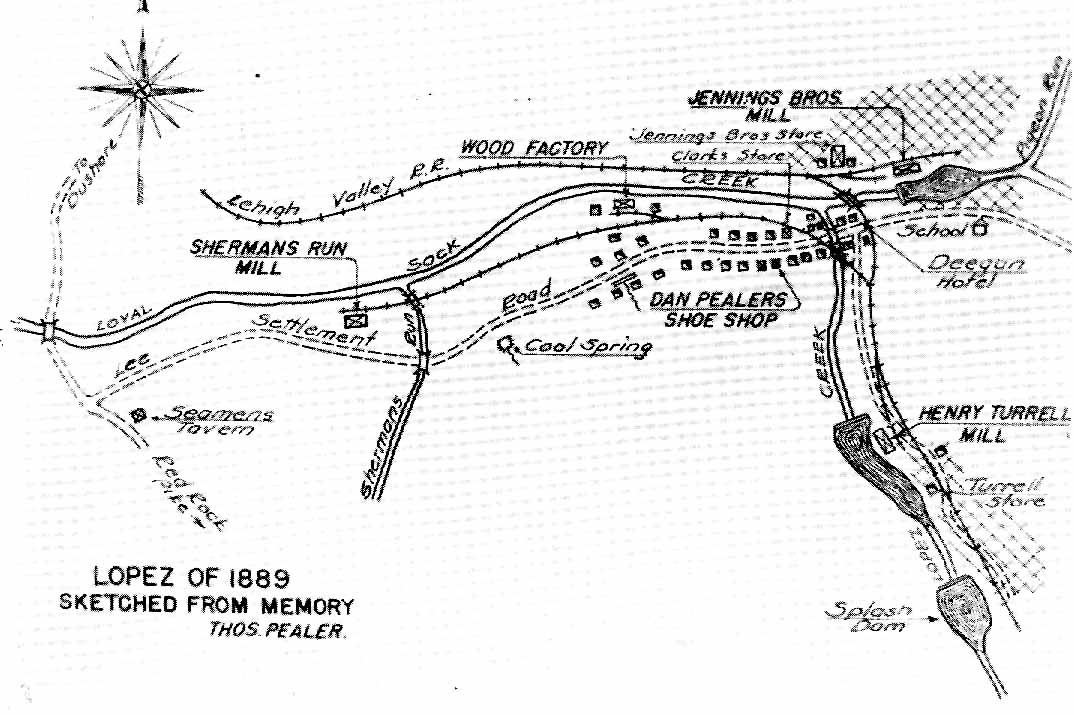
Map of Lopez in 1889
Sketched from Memory by Thomas Pealer
Photo scanned by Derek Davis
Here is a thumbnail description of the lumber town of Lopez as the author recalls it when he was a boy of six. The main street of the village was the Lee Settlement Road, which extended from the terminus of the Red Rock Turn Pike, east, through the towns of Lopez, Bellsylvania, Lovelton, Forkston and ending at Mehoopany on the Susquehanna River. At the Old Seaman farm, about two miles west of Lopez, a connecting road led to Dushore.
The Lehigh Valley Railroad was built through Lopez, connecting with the Dushore-Towanda Branch. At that time the end of the Bowmans Creek Branch was at Kipptown or Newell. However, construction was going forward for the completion of the road to Wilkes-Barre.
Jennings Brothersí large hemlock mills and lumber years were located on the north side of the Sock, about one-half mile above the Lopez Creek Junction. On the bluff, immediately above the crossing of the railroad over the Loyal Sock Creek, was the company store and the homes of the Jennings brothers. Some 75 shanties were scattered about the mill property in every conceivable wasy as if dropped from a giant balloon. In these crude dwellings lived the mill hands.
Turrelltown, the next lumber operation in importance, was about one mile south of the Lee Settlement Road. It was on the Lopez Creek and connected with the Lehigh Valley Railroad. On both sides of the railroad some thirty houses were located. In the midst was the store and office.
In addition to the two large mills described above, the town boasted of a kindling wood factory operated by McCartney and Higgins, where pressed wood packages were made from hemlock slabs, a waste product from the mills. The slabs were cut into small two-inch blocks of every shape. They were dried in bundles nine inches by six inches and tied together with tar strings. Forty to fifty boys and girls were employed as bundlers, whose average pay was 96 cents for an eleven-hour day. The factory was on the south side of the Loyal Sock at a point about one-half mile west of the Lopez Creek Junction. The McCartney home, the Jeff Jackson boarding house, and four or five shanties were in the vicinity of the factory.
On the site of the Wilhelm mill located on the Lopez Creek, just south of the Settlement Road, four houses were left which were inhabited. The small tract of timber owned by the Wilhelm people was cut out a couple of years before.
The section of town along the Settlement Road was made up of business places and private dwellings. Commencing on the north side at the railroad was the Jerry Deegan Hotel, followed by Albert Dyerís pool room, on the second floor of which was given over to all sorts of public meetings, medicine shows and the like. On the rear was the Will Johnson barber shop, where one could get a left-handed shave and a first-class hair cut for twenty-five cents. Across the creek was O. C. Cramerís nick-nack store and residence, adjoining which was Joe Penningtonís butcher shop and livery stable; after that was the store and office of Dick and Dan Clark who were log cutting and skidding contractors; close by was Wes. Johnsonís residence; following that was the Gordon millinery store; further up the hill lived Charlie Schuck, the squire and blacksmith, and Bruce Ray, the night watchman. In the hollow, south of the wood factory, dwelt three or four German families and a Mr. Parish. A landmark here that all will remember who knew the old Lopez was the watering trough on the south side of the road.
Beginning at the railroad on the sourth side was the depot, followed by Wes. Johnsonís store; next was Charlie Schuckís blacksmith shop on the bank of the Lopez Creek, across which was the Kesterís drug store; then came Howard Lawrenceís jewelry store; after that, Dan Clarkís residence; after which was the combined residence and shop of Dan Pealer; next to it was Billy Phillipís store and dance hall; and on out the road between this point and the watering trough lived the Finans, Old Dave Brown, Mr. Sadlemeyer, Jackie Schock, Dick Clark, Mr. Kelly and Charlie White.
About one mile east of the Lopez Creek, along the Lee Settlement Road, was the two-room Colley Township school house. That year the teachers were Florence Schurman and Linda Houseworth. This building was also used as a community church and township election house.
The old tar bridge was there across the Lopez Creek. The single span was supported by two built-up wooden beams about eight feet high, encased in hemlock boards. The floor system was three-by- twelve stringers and three-inch plank floor running with the road. It was a most unusual design, but it carried the load. The story goes that it was designed and built by great-grandfather Dieffenbacher when he was County Commissioner of Sullivan County. The sketch map of "The Lopez of 1889: shows many of the places described above.
Dan Pealerís shoe and harness shop was the gathering place of teamsters and woodsmen. The teamsters came to purchase rings of all sizes and colors which were laced together with fine braided leather and hung on horses for ornamental decorations. The woodsmen were there to have steel spikes driven in soles and heels of their famious Watsontown boots as much for fancy as for security on the hemlock logs. The visits of the old patriarchs from the mountains to the village always included a call at Dan Pealerís shop. Jerry Hunsinger, from the headwaters of the Sock, would tell how he acted as guide to the surveyors that located the railroad through Lopez. Mr. Behr from Shady Nook came for another game of chess. Old Mrs. Seaman, with the funny Dutch bonnet, neatly tied under her chin, dropped in for a social chat. Mr. Salsbury, from up the Settlement Road, traded turnips for half soles. Mr. Finke, from beyond the Settlement, came for a harness fix. Mr. Houseworth from Rouse Pond invited Dan for a dayís pickerel fishing at the outlet. Lucas Steafather called often and stayed long to add to his story about the experience he had in Kansas during the war. Dr. Herman, the Medic from Dushore, on an emergency call to the woods would stop at the shop and give his usual "Guten morgen mein freund." These talks were all in Pennsylvania Dutch. Dan replied in kind as he was a fluent speaker in his native tongue.
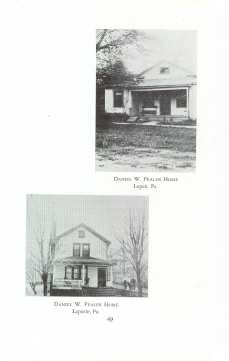
Daniel Pealer Residences
Top: Combined with Shoe and Harness Shop, Lopez, PA
Bottom: Laporte, PA
The hardships that the rough and wild life of the early Lopez entailed were in a measure offset by the natural playgrounds so dear to young folks. For within the village limits were large, clear fresh water streams, mill ponds and splash dams. On every side were natural mountain lakes. These waters offered the finest fishing in the East. Even to this day, the Loyal Sock, the Lopez, the Mehoopany, South Brook, Bowmans Creek, the Painter Den, Pigeon Creek and Glass Creek are among the noted brook trout streams of Pennsylvania. The big woods carpeted by the boughs of spruce and hemlock offered a great field for hike and play. The fall crop of beechnuts waiting to be bumped to the ground for gathering and drying, later to be crunched as delectable morsels behind the open geography in school. The summer sports were fishing, swimming and pushing the homemade rafts on the ponds and streams. Ice skating was enjoyed by young and old and was a favorite means of transportation for the boys to go from place to place on streams and dams. Fishing for pickerel through the ice with the homemade tip-up was not only a favorite sport, but a means of providing much needed fresh meat for the table.
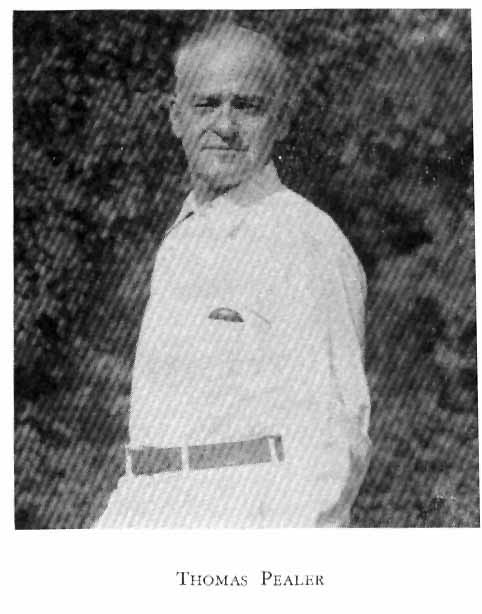
Thomas Pealer
Photo scanned by Derek Davis
THOMAS PEALER, son of Daniel W.
Thomas Pealer born August 1, 1883
Married Anna Mary Caldwell on May 25, 1909. She was born March 6, 1878.

Thomas Pealer Home
Indiana, PA

Anna Mary (Caldwell) Pealer
Children: Mary Jane, born January 8, 1912
Ruth, born March 20, 1914
Mary Jane married Russell C. Northover, April 7, 1941
Ruth Married Raymond L. Hess, July 30, 1938
Thomas Pealer, born Laporte, County Seat of Sullivan County, Pennsylvania (population 130). One time corps boy
on mine surveying party (assistant engineer, mine surveyor, land
surveyor, draftsman, professional engineer). Since 1940, Consulting Engineer, offices
in Indiana, Pennsylvania. Member, American Society Civil Engineers; Member, Professional Engineers
Society; Member, Sons of the American Revolution.
Mary Caldwell Pealer, born Indiana County. Graduated Indiana High School, Indiana State Teachers College, New York State Teachers College, Oswego, N.Y. Teacher public schools, Apollo; Critic, Teacher Bay City Training School, Bay City, Michigan.

Lieutenant Russell Northover

Mary Jane (Pealer) Northover
MARY JANE PEALER NORTHOVER, born Indiana, Penna. Graduate Wyoming Seminary, 1930, graduate Skidmore College, Saratoga Springs, N.Y. 1934; graduate Indiana State Teachers College, 1936. Before marriage was engaged as reporter and proofreader, Indiana Evening Gazette; also as field investigator and reports, Pennsylvania Welfare Department.
RUSSELL C. NORTHOVER, born Cambria County, Pennsylvania. Graduate Indiana State Teachers College, 1936; connected with the United Eastern Coal Sales Corp. Lieutenant U.S.N.R. stationed at Guam, Pacific Area, for two years. After discharge from Navy in February, 1946, he resumed position as division manager of the Syracuse office of the Coal Sales Corp. Present address 31 Hodge Ave., Buffalo, N.Y.

Raymond L. Hess

Ruth Pealer Hess
RUTH PEALER HESS, born Indiana, Penna. Graduate Wyoming Seminary, 1931; Skidmore College, Saratoga Springs, New York, 1935; Indiana State Teachers College, 1936. Teacher, Art Department, Aliquippa Schools, 1937-1938-1939-1940.
RAYMOND L. HESS, born Indiana County, Pennsylvania. Graduate Indiana High School, 1931; Princeton University, 1935; Duquesne University Law School, 1940. Present, Secretary and Attorney, Rust Engineering Company, Pittsburgh. Ray and Ruth have two children: Judy, born April 21, 1941 and Deborah, born June 24, 1945. Address, Thorn Run Road, Coraopolis Heights, Coraopolis, Pennsylvania.

The Hess Family Home
Coraopolis Heights, PA
Original Drawing by Ruth Pealer Hess
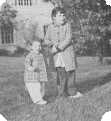
The Hess Children
Judy and Debbie
THE WENNER FAMILY
From the book entitled Pennsylvania Pioneers, Volume No. 1 by Strassberger and Hinke, it is learned that the first of the Wenners to land in America was Christian Wenner, who disembarked at Philadelphia, September 30, 1727, from the ship Molly (John Hodgeson, Master). His name appears on the same ship list as that of Johannes Pealer or Buller and is there spelled CHRISTIAN WENGER. He eventually settled in what is now Snyder County, Pennsylvania, where his son bearing the same name was born.
CHRISTIAN WENNER (great-great-grandfather) Son of Christian Wenner or Wenger
Christian Wenner born 1752; died Dec. 1822
Married Maria Barbara. She was born Feb. 10, 1765; died April 26, 1838
Children: JACOB (great-grandfather), Andrew, Daniel, George, Christian, Leonard, Jonas, Catherine, Regina, Barbara:
Military Record: Service in American Revolution, Corporal in Henry Ritz' Eighth Company of 1st Battalion of Northumberland County Militia, commanded by Lieutenant Colonel Stephen Balliet.
After the war, he returned to his home in Snyder County, later settling in Butler Township, Luzerne County, where he devoted himself to farming the rest of his life.
JACOB WENNER (great-grandfather) Son of Christian Wenner
Jacob Wenner born May 18, 1786; died Sept. 1865. Married Elizabeth Beishline. She was born Mary 14, 1792; died February 28, 1865.
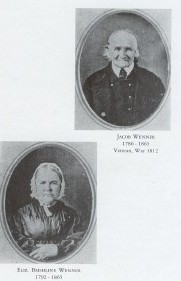
Top: Jacob Wenner (1786-1865)
Veteran, War of 1812
Bottom: Elizabeth Beishline Wenner (1792-1865)
Wife of Jacob Wenner
The history of Columbia and Montour Counties record the following children: Jacob, born October 2, 1816; Daniel, Magdalena; SUSANNAH (grandmother), born February 4, 1822; Elizabeth; Sarah; Magdalena, married Benj. Hess. SUSANNAH married Elias Bealer, October 12, 1840.
JACOB WENNER (great-grandfather), was born in Snyder County. He moved to Butler Township, Luzerne County with his father about the year 1790. After service in the War of 1812, he located in Fishing Creek Township, Columbia County where he purchased a farm in the vicinity of Stillwater. His will is recorded in the Bloomsburg Court House Will Book No. 3, page 542, probated November 2, 1865. Named therein are his wife Elizabeth, and children Jacob, John, Daniel, SUSANNAH and Mary Magdalena. Witnesses: Michael Beishline
and Charles Kindig.
ELIZABETH BEISHLINE WENNER (great-grandmother) was the daughter of Michael Beishline who came from Germany in the early part of the 18th century and settled in what is now Butler Township, Luzerne County, Pennsylvania, ELIZABETH is buried in the St. John Reformed Church Cemetery, Fishing Creek Township, Columbia County.
SUSANNAH WENNER BEALER (grandmother), one of the most outstanding characters among the authorís ancestors, was born and reared in Fishing Creek Township. She was the granddaughter of Christian Wenner, veteran of the Revolutionary War. Her father, Jacob Wenner, was a soldier in the war of 1812; and her son, Jacob ,served throughout the war between the states on the side of the Union. When her husband, Elias, died in 1863, she was left with eleven children, ranging in age from three to twenty-three and a mortgaged farm where the Union soldiers encamped the next year, and consumed her forage during the disturbance of the Fishing Creek Confederacy. Yet she raised the family, freed the farm from encumbrance and accumulated a neat sum of money.
THE LAWRENCE FAMILY
Information concerning the beginning of the Lawrence family in America is very meager. It is known, however, that they are of English descent and that early in the seventeenth century they settled in the Cape Cod country, Massachusetts, afterwards migrating to Northumberland County, Pennsylvania, where we have the first actual records.
JOHN LAWRENCE (great-great-grandfather)
John Lawrence, born September 2, 1775; died August 28, 1823.
Married Mary Morrison on April 2, 1798. She was born December 26, 1776; died Feb. 28, 1849.
John Lawrence is buried in the Quinn Cemetery, between Dushore and New Albany.
Children of John Lawrence and Mary Morrison:
Mordecai, born Jan. 4, 1807; died July 8, 1885
Susannah, born Aug. 8, 1802; died Octo. 25, 1863
WILLIAM (great-grandfather), born May 25, 1805; died Dec. 29, 1883
Margaret, born Aug. 26, 1808; died June 18, 1828
John R. born Jan. 24, 1812; diedÖ..
Mary Ann, born Sept. 9, 1818; diedÖ..
MORDECAI LAWRENCE married Elizabeth Kimball September 18, 1828. They had nine children: Harmon, Abram, Ashley, John, Fanny Elizabeth, Susan, Matilda and William.
SUSANNAH LAWRENCE married Moses Ashley Ladd Oct. 21, 1823.
WILLIAM (great-grandfather) see record.
JOHN R. married Elizabeth Hubett October 6, 1839. He frequently visited the Lawrence family at Dushore, where he was a welcome guest since he told many stories of his wanderings about the country. It seems that he was a man of means and a great traveler of his day.
MARY ANN married Abram Brewer March 2, 1847. They lived and died in Sunbury, Pennsylvania.
WILLIAM LAWRENCE (great-grandfather), son of John
William was born May 28, 1805; died Dec. 29, 1883
Married 1st Eliza Ladd on March 1, 1824. She was born June 20, 1805; died April 25, 1847.
Married 2nd Ann Manley Gage. She was born April 10, 1819; died Jan. 7, 1900.

Ann Manley Gage Lawrence
1819-1900
Wife of William Lawrence
(1805-1883)
Children of William and Eliza Ladd:
Anna Maria, born Dec. 19, 1826
Asenath Celinda, born Feb. 24, 1830
Fidelia Jane, born June 4, 1839
Parmelia Christanna, born August 7, 1840
Children of William and Ann Manley Gage:
Ada, born August 8, 1849; died January 12, 1852
William T., born February 26, 1854; died June 22, 1923.
William Lawrence (great-grandfather), was born in Augusta Township, Northumberland County, Pennsylvania, later locating in what is now Cherry Township, Sullivan County. There, in December 1825, he built a log house on land belonging to General Cadwallader of Philadelphia, acquiring later, 48 acres of this land, which was increased by subsequent purchases, to 120 acres. He was one of the first school directors in Cherry Township under the new common school law and held the office of school treasurer for six years. In 1847, he was elected County Commissioner of Sullivan County. In 1854, he was elected County Commissioner of Sullivan County. In 1854, he moved to Bradford County where he bought the Manley farm at Canton Corners. In that county he held the office of Road Commissioner for two terms. For thirteen years he was ruling elder in the Presbyterian Church. At its foundation, he became a member of the Republican Party, whose principles he ardently defended.
ASENATH LAWRENCE, the second child of William, was born in what is now Cherry Township, Sullivan County, February 24, 1830. She married Freeman Wilcox of New Albany. She is buried in the Laddsburg Cemetery.
WILLIAM T. LAWRENCE, son of William Lawrence and Ann Manley Gage Lawrence, was born February 26, 1854. He spent his entire life as a citizen of Canton Township, Bradford County. But his circle of friends was scarcely measured by the borders of the state. A farmer all of his life, he did much to improve the methods of farming in the vicinity in which he lived. His advice and wise experience were sought by different organizations. He was ruling elder of the Presbyterian Church for more than twenty-five years and for most of that time was superintendent of the Sunday School. He was president of the Grange Fire Insurance Company and a director in the Canton-Leroy Telephone Company. For several years he was justice of the peace for Canton Township. The children of William T. Lawrence: Dr. Manley S. Lawrence, Quaker City, Ohio; A.D. Lawrence, Canton, Bradford County, Pennsylvania; and Mrs. William VonDurant, Washington, D.C.

W. T. Lawrence Homestead
Canton Corners, PA
This history of the Lawrence family would be inadequate, indeed, if it did not take note of the invaluable help rendered in the preparation of it by A.D. Lawrence of Canton.
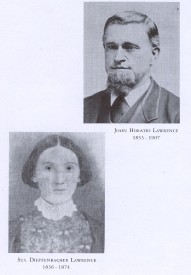
Top: John Horatio Lawrence (1833-1907)
Bottom: Hannah Dieffenbacher (1836-1874)
JOHN HORRATIO LAWRENCE (grandfather), son of William.
JOHN HORATIO LAWRENCE born April 11, 1833; died January 17, 1907.
Married Hannah Dieffenbacher in 1853. She was born February 17, 1836; died January 30, 1874.
Children:
Elizabeth Ann, born August 21, 1854; died May 27, 1928.
Ida Eliza, born July 18, 1855; died June 9, 1930
William John born February 27, 1857; died February 4, 1944
Clarence, born April 1, 1858; died April 14, 1858.
Charles Thompkins, born April 15, 1860; died September 16, 1924.
Jennie Fidelia, born September 17, 1862; died September 8, 1940
Clinton Emanuel, born October 3, 1864; died 1899
Howard Theodore, born April 27, 1866; died 1889.
Orville Horatio, born September 15, 1867; died about 1932
Celinda May, born December 19, 1869
Laura Pamelia, born April 11, 1871; died April 9, 1942
Frank Wilt, born February 2, 1873.
Elizabeth Ann married Daniel Wenner Pealer, February 16, 1875.
Ida Eliza married Daniel H. Lorah, July 2, 1882
William John married Barbara Ann Baker (nee Icid) June 13, 1877.
Charles Thompkins married Agnes Conner, December 17, 1882.
Jennie Fidelia married Jesse P. Little, March 18, 1880.
Clinton Emanuel married Mary Steafather.
Howard Theodore never married.
Orville Horatio married Laura Utz, September 13, 1887.
Celinda May married Duncan MacDonald, April 8, 1899.
Laura Pamelia married Andrew Jackson Bradley, April 1896.
Frank Wilt married Dorothy Gallup, June 1911.
JOHN HORATIO LAWRENCE (grandfather), was born and reared in Cherry Township, Sullivan County, Pennsylvania. He was educated in the common schools and took a short course at the famous Wyoming Seminary, Kingston, Pennsylvania, where he was one of the first students. At the age of twenty, he married Hannah C. Dieffenbacher, granddaughter of Conrad Dieffenbacher, Revolutionary War veteran. His early career was that of a school teacher and merchant. Later, he purchased a farm located one-and-one-half miles east of Dushore where he raised a family of eleven children. In 1865 he was elected Sheriff of Sullivan County for one term. He remained on the farm until 1888 when he moved to
Dushore and made his home with his son Charles. For twelve years he was justice of the peace, Dushore Borough, which office
he held at the time of his death in 1907.
John H. Lawrence displayed the thrift and acumen of his Yankee ancestors in his business ventures. In Sullivan County, he acquired
sufficient wealth to be looked upon as a man of means. To those in need he was kind and helpful. His advice which was sought
by so many was so cherished that he became a real country philosopher. He was so widely read that his opinions on the questions
of the day played a great part in moulding the life of the community in which he lived, so that his influence still remains a potent
factor. John Horatio Lawrence and Hannah C. Dieffenbacher Lawrence are buried in Fairview Cemetery, Cherry Township, Sullivan County.
The Sullivan Review
Dushore, Pa
January 24, 1907
John H. Lawrence, whose illness was mentioned last week, died at the residence of his son, W.J. Lawrence, in Kane, McKean county, Thursday,
Januray 17, 1907, aged 73 years, nine months and six days. The remains were brought to the residence of his son, Charles T. Lawrence ,
in this place, Friday evening, and on Sunday, January 20, funeral services were held at the Evangelical church, interment being at
Bahr's Hill.
John Lawrence was born in Cherry township April 11, 1833, and was a son of William Lawrence, who came to this county from Northumberland in 1828.
The subject of this sketch married Miss Hannah Dieffenbach, who died 33 years ago, and to them were born twelve children, nine of whom are living:
Mrs. D.W. Pealer, of Lopez; Mrs. D.H. Lorah, of Sonestown; William J. Lawrence, of Kane; Charles T. Lawrence, of Dushore; O.H. Lawrence, of
Waverly; Mrs. J. P. Little, of Stockton, California; Mrs. D. McDonald, of White Salmon, Washington; Mrs. A.J. Bradley, of Laporte, and
Frank Lawrence, of Chicago. All were present at the funeral with the exception of Mrs. Little and Mrs. McDonald. William Lawrence, of
East Canton, the only surviving brother, was also present. A sister, Mrs. Freeman Wilcox, of New Albany died
last week.
John H. Lawrence had been prominent in the affairs of eastern Sullivan county for a generation. He was a farmer and at one time was
engaged in lumbering and store keeping. He was frequently called upon to hold public office, and had filled about all the local offices,
one time and another, when, in 1865, he was chosen Sheriff of Sullivan county. About 1890 he became a resident of Dushore borough, and
in 1893 was elected justice of the peace, in which office he was serving his third term at the time of his death.
Deceased was a man who made friends wherever he went. Kindly and jovial in disposition, he had a smile an a joke for all, and under
all there was a certain gravity and dignity that betokened more serious thought. He will be greatly missed from our streets and
his death is greatly regretted by all.
ELIZABETH ANN (mother) See Pealer Family Record.

Sonestown 1910
Ida Eliza Lawrence and her Husband Daniel Lorah Ran the Lorah Hotel Here.
In fact,
this postcard was made for her use as shown on the Back Side.
Photo Contributed by Scott W. Tilden
Original auctioned on
eBay in February 2015
IDA ELIZA taught school for eight or nine terms before her marriage to Daniel Lorah, July 7, 1882. The Lorahs lived at Sonestown, Sullivan County where they ran the Lorah Hotel. Their two sons, Walter and Lloyd, both graduated from Pennsylvanina State College as Civil Engineeers. Walter, a member of the American Civil Engineers, was on construction, Panama Canal, the Cape Cod Canal, the DuPont Company, Delaware and the Hudson Vehicular Tunnels. He died in 1926 at the age of 43. Lloyd, a noted collegiate wrestler, was on the Panama Canal, later employed by the Highway Department of Pennsylvania. At present, surveyor, professional engineer and contractor, Smithport, McKean County, Pennylvania. Ida Eliza showed marked business ability. After the death of her husband, she was proprietress of the Lorah Hotel, ran a country store and millinery shop, did some dressmaking on the side, and looked after a farm back in the country. A couple of years before her death, she took a trip by herself to the west coast to visit her sisters, Jennie and Linda.
WILLIAM JOHN, the oldest son of John Horatio, was the mainstay on the farm after the death of his mother. For a term or two he taught school and afterwards he went to the hard coal field where he learned the carpenter trade. At the age of twenty, he married Barbara Ann Baker. They had five children: Grace, Eva. Saylor, Harriet and John. Grace, Eva and Harriet are presently residing at 117 Chestnut Street, Narbeth, Pennsylvania. Saylor died in Canada in the year 1943. John lives at 407 East Park Street, Wauseon, Ohio.
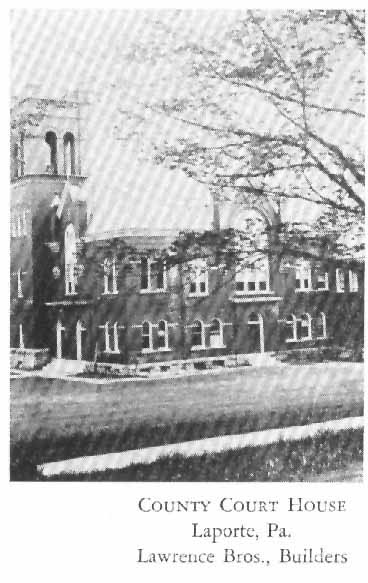
County Courthouse
Laporte, PA
Lawrence Brothers Builders
Photo scanned by Derek Davis
William John formed a partnership with his brother Charles under the firm name of Lawrence Brothers, contractors and builders, Dushore, Pennsylvania. They erected many buildings in the northesast section of Pennsylvania, among which are the courthouse, Laporte, the Roman Catholic Church and Manse, Sugar Hill, and the court house at Troy. Later, they engaged in the lumber business at Muncy, Pennsylvania, at Kane, McKean County and in Ontario, Canada. William J. was elected Prothonotary, Sullivan County and served two terms. Special mention is due here to Eva Lawrence, daughter of William J., who furnished records from her own private collection for use in compiling much of the historical data concerning the Lawrence and Ladd families. She was untiring in her efforts, prompt in response and ever willing to lend a hand to help put together this brief family record.

William John Lawrence
1857-1944

Eva Lawrence
Daughter of William John Lawrence
CLARENCE died in infancy
CHARLES THOMPKINS first learned the undertaking business at Dushore, after which he became a carpenter.
December 17, 1882, he married Agnes Conner of Brooklyn. They had two children:
Elsie, a school teacher and Red Cross field agent, and Emma Margaret, who married John
W. Onterson. Charles T. was associated with his brother William J. in the building,
contracting and lumber business for many years.

Charles Thompkins Lawrence
1860-1924
Son of John Horatio Lawrence
Sullivan Review and Gazette and Herald
Dushore, PA
Wednesday, Spetember 17, 1924
Chas. T. Lawrence
Chas. T. Lawrence died suddenly Tuesday afternoon in Philadelphia at the age of 63 years.
Mr. Lawrence was a son of the late Mr. And Mrs. John H. Lawrence of this place and a member of the firm of Lawrence Bros. Who for many
years were engaged in contracting and building in this county.
After the dissolution of the firm, Mr. Lawrence moved to Canada where he engaged in the lumber business. His wife died about
two years and since that time Mr. Lawrence has made his home in New Jersey with one of his daughters.
He is survived by two daughters, Miss Elsie Lawrence, who resides in the west, and Miss Emma Lawrence with whom he lived. Also five
sisters and three brothers, William H. Lawrence of Conshohocken, Pa.; O. H. Lawrence of Utica, N. Y.; Frank Lawrence of Chicago, Ill.;
Mrs. Ida Lorah of Sonestown, now visiting in the west; Mrs. Elizabeth Pealer, Lopez; Mrs. Jennie Little, of California; Mrs. Laura
Bradley, Cleveland, Ohio; and Mrs. Linda Mc Donald of Washington.
The body will be brought to Dushore Friday morning and interment will be made in the Bahr Hill cemetery at 10 o'clock a. m.
Evergreen Lodge, F. & A. M. of Monroeton and Dushore Lodge No. 494, I. O. O. F. will have charge of the services at the grave.
JENNIE FIDELIA taught school for several years before her marriage to the Superintendent of the Sullivan County schools, Jesse P. Little. The Little family moved to Oakland, California in the early nineties and have since resided there. The Littles had seven children: Anna, Edith May, Ernest Lawrence, Blanche, Edwin, Edna, Jesse Buffington.
CLINTON EMANUEL, by trade a carpenter and builder. He married Mary Steafather of Lopez. They had three children: Howard, Fluetta and Blanche. Howard, a telegrapher, served overseas in the first World War. Fluetta and Blanche were both trained nurses practicing in California where they moved with their mother in 1917. Later, Blanche married Ivan Wallace of Los Angeles. Clinton Emanuel died in Lopez in 1899 and is buried in Fairview Cemetery, Dushore.
HOWARD THEODORE learned the trade of jeweler at Picture Rocks, after which he established a store at Lopez where he died in the year 1889. Howard was by nature an inventive genius, evident from the fact that after his death were found among his many possesions many models and drawings of new appliances, the outstanding one being the crimped elbow made from a single joint of pipe, which was later patented by his brother Orville.
ORVILE HORATIO, while still a young man, patented the crimped pipe elbow, which his brother Howard had previously designed. A plant for manufacturing this invention was erected at Waverly, New York, where great quantities of the "O.H." elbows were made for stove pepes, lantern pipes and roof spouting. This product was sold in every civilized country of the world. Orville married Laura Utz of Dushore, September 13, 1887. They had four children: Barbara, Nina, Courtney and Frances. Barbara married John Filer, Miami, Florida. Nina married Joe Grumme, 811 West First Street, Elmira, New York. Courtney and Frances, deceased. Orville Horatio sold his interests in the elbow concern and became associated with his brothers, William J. and Charles T. in the lumber business in Ontario, Canada. Orville H. and wife are both buried in Athens, Pennsylvania.
LAURA PAMELIA was a school teacher for six years or more before her marriage to Andrew Jackson Bradley, Attorney, Laporte, Sullivan County. From Laporte they moved to Ohio where their daughter Edna, an only child, lives. She is an art teacher in the Cleveland High Schools and lives at 1606 Elbur Avenue, Lakewood, Ohio.
CELINDA "Linda" MAY and Laura were school teachers together. During vacations they lived with their sister Ida at the Lorah Hotel, Sonestown.
Linda continued her school work until she married Duncan MacDonald. The MacDonalds live at Washougal, Washington.
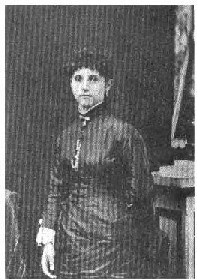
Celinda (Lawrence) McDonald
Born in 1869
Daughter of John Horatio Lawrence
Photo scanned by Derek Davis
FRANK WILT, a journeyman machinist, married Dorothy Gallup in June 1911. For several years he was connected with the Standard Roller Bearing Company, traveling as their representative in the Chicago district. Later, he was associated with Gar Wood in the manufacturing of hydraulic hoists at Detroit, Michigan. Frank retired from business in 1924.
THE LADD FAMILY
The career of the Ladd family in America begins with Daniel Ladd, who took
the oath of supremacy and allegiance to pass to New England on the ship Mary and John,
March 24, 1633. February 5, 1637, he was in Ipswich, Massachusetts.
Editor's Note: Per Donald L. Ladd message of March 24, 2004:
You will note that in your source that this date is most likely listed as
24 March 1633/34. 1633 would be the year if using the "old" calendar system but would be
1634 if using the "new" calendar system.
In other words; 24 March was the last day of the month in the year 1633, but would be the
third month in the year 1634. England did not adopt 01 January as the first day of a new
year until in September 1752 which would then have shorted 1752 by three months.
[25 March to 31 December 1752]. Previous to that time most all sources listed the year by the two year indicator.
Daniel LADD, on the Mary and John, would have arrived in Boston Harbour
about the end of April or possibly the first week[s] of May. Previous sailings of the
Mary and John took about six weeks to make the trip from the Thames River to
Boston Harbour.
Donald Ladd is the Directory Manager for The Ladd Digging Ground, a Ladd family
genealogical site.
Following is the direct line of descendants of Daniel Ladd to Eliza Ladd, the wife of great-grandfather William Lawrence.
Daniel Ladd (g-g-g-g-g-g-g-grandfather) died July 27, 1693
Married Anna ? She died February 9, 1694.
Samuel Ladd (g-g-g-g-g-g-grandfather) born November 1, 1649; died February 25, 1698.
Married Martha Corliss
Jonathan Ladd (g-g-g-g-g-grandfather) born April 13, 1682
Married Susannah Kingsbury. She was born Decmeber 23, 1713.
Ezekiel Ladd (g-g-g-g-grandfather)
Married Hannah Bigelow
Ezeliel enlisted in the Conn. militia, Captain Orcutt's Company, commanded by Colonel Samuel Chapman, August 3, 1778 and was discharged September 21 of the same year.
Ephraim Ladd (g-g-g-grandfather) born May 11, 1749; died May 4, 1836
Married July 14, 1774 to Louise Chapman. Born Jan. 28, 1756; died May 2, 1836.
EPHRAIM assisted in establishing American Independence. He marched in Boston in Captain Orcutt's Company, April 1775. In the year 1800, he migrated from Tollard, Connecticut to Bradford County, Pennsylvania.
HORATIO LADD (great-great-grandfather), son of Ephraim.
Horatio Ladd born January 21, 1780; died January 12, 1850.
Married January 30, 1800 to Asnath Ives. She was born Oct. 18, 1775; died August 28, 1854.
Children:
Clarissa, born October 4, 1800; died May 1864
Moses Ashley, born July 23, 1802; died June 20, 1886.
Lucinda, born Sept. 7, 1807; died June 14, 1814
Olivia, born May 25, 1810; died Sept. 12, 1847.
Arunah, born June 6, 1812; died July 20, 1814.
Lucinda, born Nov. 12, 1814; died Oct. 26, 1840
ELIZA LADD (great-grandmother), born June 20, 1815; died April 13, 1847.
Asenath Celinda, born April 13, 1817; died April 13, 1900.
Arunah, born March 14, 1820; died May 4, 1909.
HORATIO and his wife, Asnath, came to Bradford County, Pennsylvania with his father Ephraim in the year 1800. He rented the Scott farm two miles from Towanda, residing there until April 5, 1805, when he moved to Albany Township where he bcame a large landowner. He was a member and liberal supporter of the Presbyterian Church and was a man of honesty and integrity. HORATIO LADD and Asenath (Ives) Ladd are buried in the Laddsburg Cemetery.
The Ladds were ever a family of pioneers. Thirteen years after the Pilgrim Fathers set foot upon the shores of Plymouth, the Ladds landed in New England to become part of that immigration which began three years before, continued until 1640 and was not resumed again to any extent until 1820. These hardy settlers were imbued with two ideas, the right to worship God according to the dictates of their own conscience and to govern themselfes in local affairs without too much interference from the outside. Into the spirit of that life the Ladds entered and when the American Revolution broke out, which was really fought to maintain those principles, they, in common with many others, were ready to enlist under the patriot banners. When independence was finally achieved, multitudes left New England in search of better living conditions. The Ladds were a part of that host and they found in what is now Bradford County, Pennsylvania, a land of promise, where they have since remained.
THE DIEFFENBACHER FAMILY
CONRAD DIEFFENBACHER, son of Leinhart Dieffenbacher, the first of the family in America, was born in Baden, Germany and landed at Philadelphia when he was 23 years of age Pennsylvania German Pioneers [Volume No. 1, by Strassberger and Hinke, pages 695-696] shows Conrad Dieffenbacher on passenger list (247C) of the ship Richmond (Charles Younghusband, Captain) arriving at Philadelphia from Rotterdam, November 29, 1766.
CONRAD DIEFFENBACHER (g-g-g-grandfather) Son of Leinhart
Conrad Dieffenbacher born March 1, 1743; died Aug. 6, 1813
Married Catherine Betz. She died January 3, 1809.
Children:
Abraham, born November 16, 1769
John, born July 13, 1771
Frederick, born May 4, 1773
Jacob (g-g-grandfather) born November 19, 1775
Philip, born February 3, 1778
Henry, born January 31, 1780
Elizabeth, born May 11, 1782
Conrad, born February 15, 1785
Catherine, born May 2, 1787
Davis, born June 17, 1789
Susannah, born August 31, 1791
CONRAD settled in the Faulkner Swanp Settlement, Pennsylvania shortly after his arrival in America. He afterwards moved to Limerick Township, Philadelphia County, now Montgomery County. His name is found on the supply tax list there for 1780 and 1782. In 1783 he owned 150 acres of land, two horses, three cows and three sheep. Military Record: American Revolution, Captain Isaiah Davis Company, commanded by Lieut. Colonel Anton Biting, 3rd class of the 4th battalion. The company, made up of 1-2-3-4 classes, called into service October 1781. Also, Henry Boyer, 6th Company, 4th Battalion, 3rd Class. [Reference: Pennsylvania Archives, Sixth Series, Volume 1, pages 778-794] Montgomery County Militia, 1785, commanded by Matthew Brook. [Reference: Pennsylvania Archives, Sixth series, Volume 3, page 662] About the year 1800, he moved to what is now Columbia County, where he died August 6, 1813.
JACOB DIEFFENBACHER (great-great-grandfather) Son of Conrad
Jacob Dieffenbacher born November 19, 1775; died October 30, 1840
Married Christina Gardner. She was born Feb. 15, 1774; died December 21, 1858
JACOB DIEFFENBACHER, the third son of Conrad, the Revolutionary War Veteran, was born in Montgomery County, near Philadelphia, where his father then resided, moved with his parents to Columbia County about the year 1800, where he married Christina Gardner of Lycoming County and became the father of eleven children.
Susan, married Jacob Fulmer
Daniel
Elizabeth, married Christol Springer
Sarah, married William Kisner
Charles of Overton
John (great-grandfather)-see record
Hannah, married Adam Thrasher
Mary, married Anthony Weaver
Jacob of Cherry
Henry of Colley
Rebecca, married Amos Reeser
In 1829, he moved to Dushore, Sulivan County. Jacob was a miller by trade, operating grist mills in Columbia and Sullivan Counties. Jacob Dieffenbacher and Christina Gardner Dieffenbacher are both buried in Thrasher's Cemetery near Dushore.
JOHN DIEFFENBACHER (great-grandfather) son of Jacob
John Dieffenbacher born March 29, 1813; died August 22, 1903
Married 1st Elizabeth Hoffa. She was born April 10, 1819; died November 11, 1886.
Married 2nd Caroline Hoffa Suber born April 18, 1827.
In 1835, John Dieffenbacher married Elizabeth Hoffa, the daugher of Catherine Schwalm Hoffa of Schuykill County. Some time after her death in 1886, he maried her sister, Mrs. Caroline Suber.
Children of John & Elizabeth Dieffenbacher:
HANNAH (grandmother) born Jan. 4, 1836; died Jan. 30, 1874.
Jacob born November 26, 1837; died Oct. 1, 1840
Daniel E. born Oct. 11, 1839; died June 7, 1919
John S. born Oct. 29, 1841; died Oct. 11, 1862
Henry born Dec. 15, 1843; died Feb. 6, 1871
Catherine Angie born March 19, 1846; died May 16, 1918
Clinton, born July 20, 1850; died June 7, 1933
George F. born June 6, 1858; died March 20, 1923
Elizabeth L. born Oct. 29, 1864; died Dec. 30, 1942
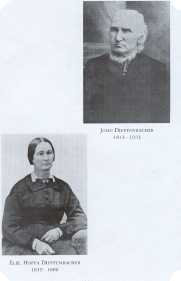
John Dieffenbacher (1813-1903)
and Elizabeth (Hoffa) Dieffenbacher (1819-1886)
JOHN DIEFFENBACHER, the sixth child of Jacob, was born in Columbia County, Pennsylvania and at the age of 16 migrated to Sullivan County with his parents. There until 1840, he assisted his father in the construction and operation of grist mills. At that time he acquired a mill of his own and for ten years wass actively engaged in this business. Then he purchased a farm one-and-one half miles east of Dushore, where he lived for the remainder of his life. During this time he was engaged in farming, design and construction of grist mills and saw mills. He also designed and erected covered highway bridges, noteworthy among which was the Tar Bridge, across the Lopez Creek on the Lee Settlement Road and the following bridges across the Loyal Sock Creek: The Seaman Bridge, near the terminus of the Red Rock Turnpike, the Ringdale Bridge at Ringdale, the Forksville Bridge at Forksville.
In 1857, he was chosen County Commissioner of Sullivan County and served in that capacity for two terms. John Dieffenbacher and Elizabeth Hoffa Dieffenbache are buried in Thrasher's Cemetery, near Dushore.
HANNAH (grandmother)-see Lawrence Record
DANIEL E (Uncle Emanuel), maried Loretta Zaner. He lived on a farm in Cherry Township, Sullivan County, adjoining the John H. Lawrence farm on the north.
JOHN S., Veteran, Civil War. Lieutenant, Company D., 141st regiment, P.V.I. died in the army, October 11, 1862.
HENRY was also a veteran of the Civil War.
CATHERINE ANGIE married Julius Vogel. At one time they had a small store at Mildred, Sullivan County; afterwards, they moved to Sayre. They had no children.
CLINTON maried Caroline Kinsley. He was a farmer in Cherry Township, near Dushore. They had four children; Morgan, William, Mary, and John.
GEORGE F. was a contractor and builder, Columbia County. Fist wife: Ada Behr (two children: John and Fred); Second wife; Gertrude Strong; third wife, Minnie Schwinn.
ELIZABETH L. married George Heverly. Two children: Ford E. and Angie E.
Credit for the foregoing historical data on the Dieffenbacher Family is due to the help of Angie Heverly of Sayre, Pennsylvania, daugher of Elizabeth Dieffenbacher Heverly.
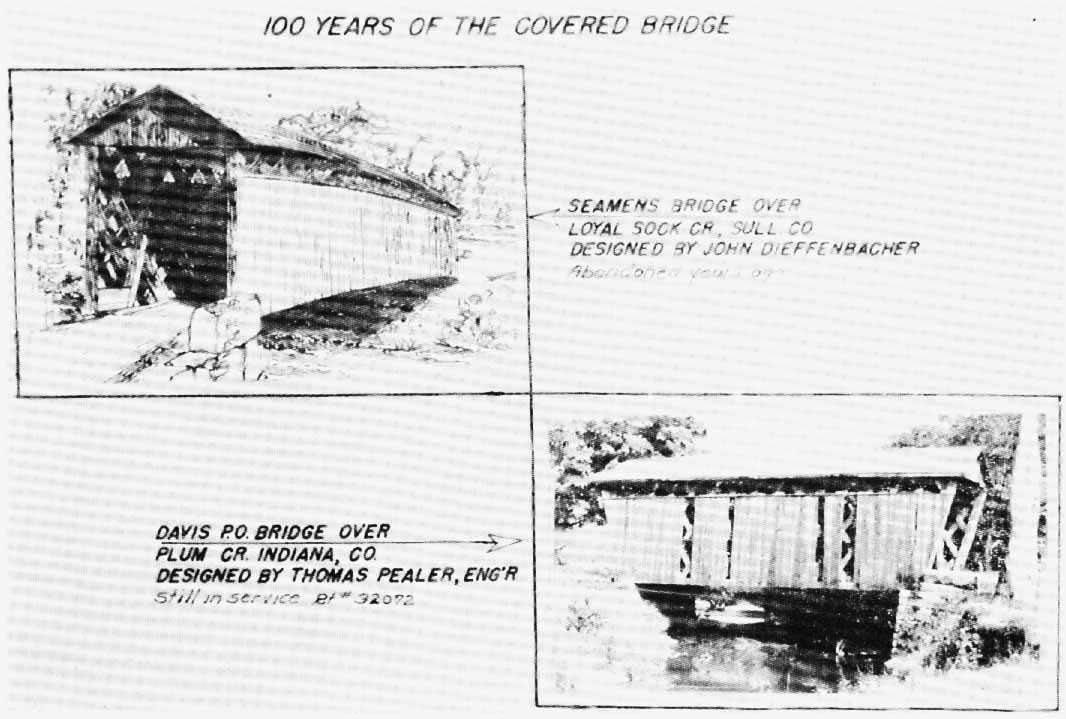
100 Years of the Covered Bridge
Photo scanned by Derek Davis
CONCLUSION
This work owes its origin to a scrap book in shich was compiled records, pictures and bits of family history, made for my own amusement and entertainment. Later a graphic chart or outline was drafted showing direct line ancestors and descendants. For the preservation of the records thus accumulated, the idea of this book naturally followed. If time, cost of research and publication had been foreseen, this work might not have been undertaken. But here it is, with my compliments to the surviving members of the five families.
Thomas Pealer
Transcribed for the Sullivan County Genealogical Web Project
by Tina Pastusic.
Copyright © 2003 Robert
E. Sweeney and individual Contributors. All Rights Reserved. Prior written
permission is required from Robert E. Sweeney and individual Contributors before
this material can be printed or otherwise copied, displayed or distributed
in any form. This
is a FREE genealogy site sponsored through PAGenWeb and can be reached directly
at ~Sullivan County Genealogy Project (http://www.rootsweb.com/~pasulliv)
|
